If you’re a beginner welder or looking to buy your first welder, you’ll probably want something that’s inexpensive, easy to use, gets good results and doesn’t have loads of unnecessary features or power. We’ve selected our top welders for beginners based on this criteria.
The best welders for beginners are MIG welders that run off 120v power because they’re easy to use and you can run them off your standard household power source. We’ve also included the best stick welder for beginners and the best TIG welder for beginners in our top picks, in case you’re looking to branch out into one of those welding processes.
If you’re confused about the different types of welding, we’ve explained everything below along with reviews and information about each of our top picks.
Contents
Best Welders for Beginners
Below is a comparison chart of the best welders for beginners on the market.| Welder | Image | Max Amp | Volts | Process | Duty Cycle | lb | Stars | Price | More |
|---|---|---|---|---|---|---|---|---|---|
Hobart Handler 140 Best Overall Best Overall | 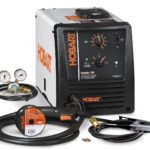 | 140 | 120V | MIG/ Flux | 20%@ 90A | 57 | 4.8/5 | $$ | Review |
Miller Millermatic 141 Best if Money isn't an Issue Best if Money isn't an Issue | 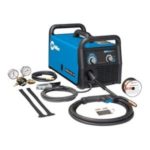 | 140 | 120V | MIG/ Flux | 20%@ 90A | 51 | 4.8/5 | $$$ | Review |
| Lotos MIG140 | 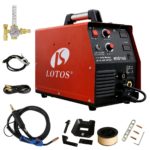 | 140 | 120V | MIG/ Flux | 20%@ 90A | 54 | 4.6/5 | $$ | Review |
Lincoln K2185-1 Best for Small Projects Best for Small Projects | 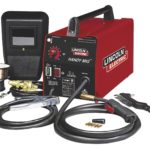 | 88 | 120V | MIG/ Flux | 20%@ 70A | 46 | 4.6/5 | $$ | Review |
Forney 261 140 FC Best flux only Best flux only | 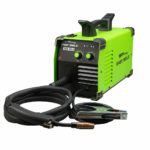 | 140 | 120V | Flux | 30%@ 90A | 19 | 4.6/5 | $ | |
| Amico Power Arc 160D | 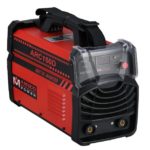 | 160 | Dual | Stick | 60%@ 130A | 15.4 | 4.5/5 | $ | |
AHP AlphaTIG 200X Best for TIG Best for TIG | 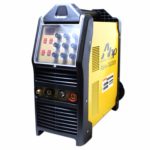 | 200 | Dual | TIG/ Stick | 60%@ 200A | 50 | 4.4/5 | $$$ | Review |
1. Hobart Handler 140
![]() Best Overall
Best Overall
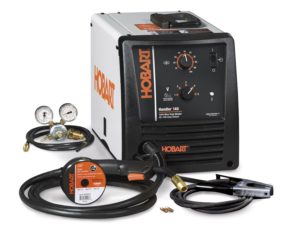 |
|
This is one of the most popular welders on the market that gets quality results and has been proven to stand the test of time. Moreover, it’s available at a great price! You can weld up to 1/4 inch steel and plug it into your household power supply so it’s perfect for pretty much any household project, metal sculptures or autobody work. The user interface is simple to use and there’s a chart on the inside of the machine which gives setting recommendations depending on the material you’re working with. If you’re getting into welding and consider yourself a ‘hobbyist’, you can’t go wrong with the Hobart 140.
|
Specs Duty Cycle: 20%@90A |
Pros
Cons
|
2. Miller Millmatic 141
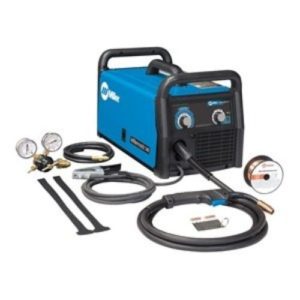 |
|
If you have a bit more of a budget available, the Miller Millermatic 141 will be the best choice if you’re a beginner. This doesn’t come cheap, but there are a whole range of features that come with it to make your life easier. The most notable is the auto-set feature. Auto-set means that all you need to do is key in the wire diameter and material thickness and they’ll automatically detect the optimum settings and you’ll be able to start welding right away. This can save a lot of time if you’re a beginner and don’t already know the best settings. If you get a bit more advanced and want to select settings manually, then this has the option of infinite voltage and infinite wire feed speed control for maximum versatility. Aside from this, this is build to the highest manufacturing standards! If money isn’t an issue, the Millermatic 141 is a no-brainer.
|
Specs Duty Cycle: 20%@90A |
Pros
Cons
|
3. Lotos MIG 140
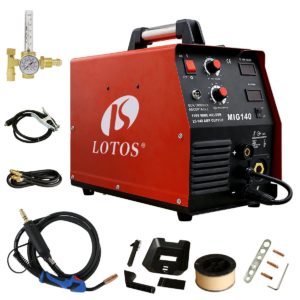 |
|
The Lotos MIG140 is a more budget option welder for beginners. If you’re only going to use your welder sparingly, this might be a better option that the Hobart or Miller machines. They’ve built this with beginners in mind and have an increased setup time with an easy to use front panel and digital display. It doesn’t have the same build quality as Lincoln, Miller or Hobart, but it’s still a good machine that’s a lot more reliable than a cheap Chinese MIG welder. It’s definitely worth considering if you want to save a bit of money.
|
Specs Duty Cycle: 20%@90A |
Pros
Cons
|
4. K2185-1 Handy Mig
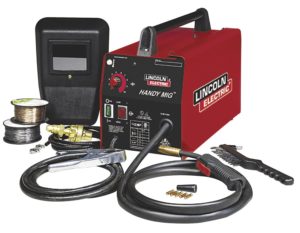 |
|
The Lincoln Handy MIG is a reliable little welder that gets quality results. If you’re only going to be welding thin metal 1/8 inch and under but want something you can rely on, this is the perfect welder. It doesn’t have much power and has a maximum of 88A output. Lincoln are known for making some of the best quality welders money can buy, so this is a good opportunity to get a welder of the highest manufacturing quality and a cheap price. If you think you might need to weld something a little thicker that 1/8 inch then you should look at a more powerful machine.
|
Specs Duty Cycle: 20%@70A |
Pros
Cons
|
5. Amico Power Arc160D
![]() Best Stick Welder for Beginners
Best Stick Welder for Beginners
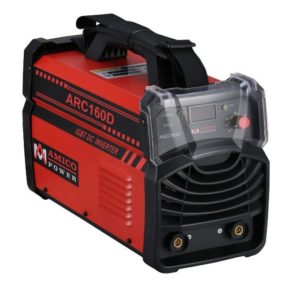 |
|
The Amico PowerArc is the cheapest welder in our top picks for beginners that is only capable of Stick welding. Stick welders are generally cheaper than MIG welders because they get less quality results. The PowerArc is a qulity stick welder that has more power than the 120V MIG welders and runs off both 120v and 240v power. It’s also super lightweight at just 15.4lbs. If you’re not bothered about messy welds but just want something cheap but reliable that you can use for quick farm repairs, this is the best welder for you.
|
Specs Duty Cycle: 60%@130A (110v) |
Pros
Cons
|
6. AHP AlphaTIG 200X
![]() Best TIG Welder for Beginners
Best TIG Welder for Beginners
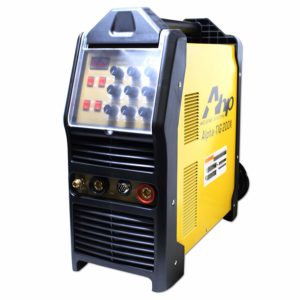 |
|
Our final pick is the best TIG welder for beginners. If you’re a beginner that’s getting into welding for the first time, we don’t recommend this machine because TIG is the hardest welding process to learn. If you’re a welder with some experience in MIG or Stick but are looking to learn TIG welding, this is our top pick. This is one of the cheaper TIG welders on the market that gets incredibly good results on both steel and aluminum. It’s dual voltage oerforms well on both 110v and 220v. Furthermore, it has a great duty cycle of 60% @ 200A. People weren’t too sure if these would stand the test of time like Hobart, Miller and Lincoln, but they’re been around a while now and AHP have received some amazing feedback. Definitely worth it for the money.
|
Specs Duty Cycle: 60%@200A |
Pros
Cons
|
Types of Welding
Below is an overview of the main different types of welding processes that you can perform. These are MIG, TIG and stick welding. The most suitable welding process for beginners is MIG welding, but we’ve outlined the pros and cons of each method below.
MIG Welding (GMAW)
MIG welding is the process of using a MIG welder to feed a wire electrode through a MIG gun. An arc is then formed between the wire and the metal to melt and fuse them together. Shielding gas is also released by the MIG gun which surrounds the wire and protects the weld pool from being contaminated by the atmosphere.
MIG welding is the most popular form of welding, especially among beginner welders. This is because it’s quite easy to learn so people who’ve never welded before can get started and get results in relatively little time.
There’s also much less cleanup than stick welding. The shielding gas prevents spatter so you don’t have to chip or brush away the slag once you’ve laid your bead. Finally, you can lay your weld quickly so your productivity is increased and you can weld on thin and thick metal.
the main disadvantages are that you can’t use a MIG welder outdoors because the wind will blow the shielding gas and stop it from protecting your weld. Also, the results are as good quality as TIG, but will be more than good enough for any beginner welder working on tasks in a workshop or around the house. Most of the welders we’ve chosen for beginners are MIG welders because they have the perfect mix of quality, price and ease of use. We’ve recommended the Hobart Handler 140 as the best welder for beginners for MIG welding.
Stick Welding
Stick welding is another popular welding process that is harder to learn than MIG but not that difficult. One of the attractive things about stick welding is the price and portability of stick welders. If you’re on a low budget they are a great option because they cheaper and don’t require a wire feeder or gas cylinder. You can also stick weld outdoors because it doesn’t use shielding gas.
Stick welding is performed by striking an arc between the base metal and a consumable flux-coated electrode. The electrode contains filler metal which melts into the pool and fuses the metals together. This creates a lot of spatter and can take a lot of time to clean up. we recommend the Amico Power Arc 160 as the best welder for beginners for stick welding.
TIG Welding (GTAW)
TIG welding is a welding process that requires high levels of skill. It’s generally not a good choice for beginners, you’d be better off getting started with a MIG welder.
TIG welding is performed by creating an arc between a non-consumable tungsten electrode and feeding wire into the weld pool which melts and acts as filler metal. Shielding gas is also released which protects the pool from contamination. There’s a lot to focus on here, you’ll be using two hands and feeding the wire with a foot pedal.
TIG is ideal if you’re looking for high-quality, intricate welds. It’s perfect for detailed work which required precision. However, it isn’t the best choice for beginners. We’ve included one TIG welder in our top picks (the AHP AlphaTIG) because it’s also capable of stick welding and it’s available at a great price.
Important Criteria for Beginners to Look Out for
Below are some of the key things that beginners should look out for when choosing a welder. The process type is very important, but you should also consider the input power, output power, weight, price, usability and features.
Power Supply
There are three primary types of power input capability for welders: 110v, 220v and dual-voltage. 110v welders are the most suitable for beginners because they’re compatible with your standard household power outlet. 220v welders give you more power but you’ll need a generator or another 220v power source, which you won’t find in every home. Also, most beginners won’t require 220v power anyway as a 140a welder that welds up to quarter inch steel will be powerful enough for most home repair projects. A dual voltage welder is a welder with the capability for both of these types of power input. These are generally quite a bit more expensive, professional welders.
User Interface
When you’re ready to lay your first weld, the last thing you want is a hundred different buttons and settings to choose from before you can get started. Dial-in settings are a useful feature to have so you can easily input the parameters and the welder will do the rest.
Budget
For much to pay for your first welder can be a tough decision. More expensive welders offer features that make life easier for beginners such as automatically adjusting the settings to save you time. However, you may not wish to invest a huge sum of money when you’re just starting out. If you already have a budget in mind, that’s great, we’ve included welders at a range of prices to suit different budgets.
You should consider what your goals are and if you’re thinking about branching out in the future. If you’re starting out with MIG welding but have plans to learn TIG as soon as you’ve got a bit more experience, then it might be worth considering a multi process welder instead to save you money in the long run.

 (5.0 / 5)
(5.0 / 5) (4.5 / 5)
(4.5 / 5) (4.8 / 5)
(4.8 / 5) (4.0 / 5)
(4.0 / 5) (4.7 / 5)
(4.7 / 5) (4.6 / 5)
(4.6 / 5) (3.5 / 5)
(3.5 / 5) (4.4 / 5)
(4.4 / 5)